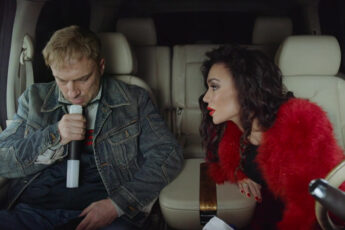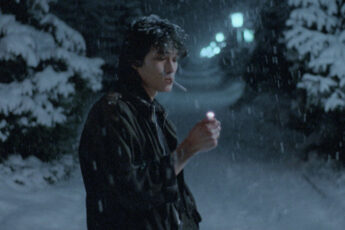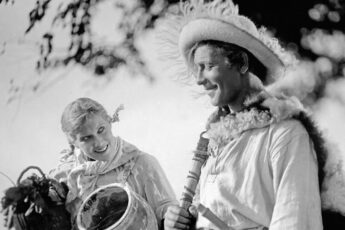The Musical Film Comedy, or “Be Embraced, Millions”
Motivic Merrymaking in the Musical Films of Grigori Aleksandrov and Ivan Pyryev
Vol. 110 (December 2020) by Wolfgang Thiel
There are works of cheerful musical theater that are not called “musicals” and yet are. In the Soviet sound film of the 1930s and 1940s, this applies to the genre of musical film comedies, which have numerous features that sufficiently differentiate them from the classical and late romantic European operetta. The great success of these musicals showed the audience’s longing for entertainment and distraction from their hard work and everyday lives. In the early 1930s, Sergej Eisenstein and fellow director Grigori Alexandrov traveled to Hollywood to get to know the successful production conditions of the American dream factory on the spot. Beyond all ideology, the studios of Mosfilm and Hollywood were united by the endeavor to make cinema for an audience of millions. When the talkies began, however, Hollywood studios were technically far better equipped to continue working towards this ambitious goal. Both directors returned to the Soviet Union with different conclusions for their own work.
Musical comedies became Alexandrov’s focus of interest. Jolly Fellows (Vesëlye rebiata, 1934) shows the appropriation of stylistic means of the Hollywood music film in a very carefree way; whereas in the subsequent film Circus (Zirk, 1936), political objectives and ideological implications were decisive in shaping the storytelling and the musical and dramaturgical conception.
The following study focuses on the comedies of Grigory Aleksandrov and Ivan Pyryev. There were other directors like Alexander Ivanovskij (Anton Ivanovich Is Angry, 1941) who also worked in this genre. But Aleksandrov and Pyryev, in collaboration with the composers Isaak Dunajevskij (1900-1955) and Tikhon Chrennikov (1913-2007), set standards for the Soviet musical productions. In their film musicals we find elements of operetta, revue, musical comedy as well as slapstick burlesque, sentimental melodrama and martial propaganda film in different combinations. And instead of the traditional operetta cast with their schematized and antiquated role repertoire, they used actors who sang, danced and acted with miming and gestures in a wide variety of plot subjects. Some of them, like Leonid Utjosov or Ljubov Orlova, would become stars of this genre.
When, after the turmoil of the Russian Civil War (1917-1922), life gradually normalized and a modest rise in living standards was felt, especially in the cities, the time seemed to have come to focus on the more pleasant and cheerful side of life on stage and in film. However, in the 1920s, Soviet comedies were mainly eccentric grotesques, featuring groups of people such as aristocrats, kulaks or priests who were denounced as reactionary forces, “enemies of the people” who were ultimately to be eradicated.
A sound film echo can be found in Puppets (Marionetki), a 1934 satirical political comedy with marionette dolls, live actors, singing and revue elements. The hysterically exaggerated operetta music by Leonid Polovikin (1894 – 1949) underlines the marionette-like with a “pointed” instrumentation of woodwinds, xylophone, and glockenspiel. It touches upon Dmitri Shostakovich’s Offenbachiads, the over-the-top cancans and galops that, as in the prologue to the film Maxim’s Youth (Yunost Maksima, 1935), serve to critically characterize the morally depraved and parasitic upper class.
At the beginning of the 1930s, the Soviet Union was politically and economically consolidated to such an extent that it seemed possible to liberate film art from its strictly defined propagandistic and agitational role, which had been under particular scrutiny of ideological maxims. This intention on the side of filmmakers coincided with the desire of the audience for humorous entertainment. In the “March of the Merry Boys”1 the shepherd Kostja (Leonid Utesov) sings programmatically: “A song helps us to live and love … We can sing and laugh like children in the midst of the existing struggle and ongoing work” (Text: W. Lebedev-Kumach). Since every statement made by the dictator has binding effects in a totalitarian state, Stalin’s statement of 1935 that “Life has gotten better, comrades, life has become happier”,2 was not just an encouragement, but rather an invitation to create works of art that had to depict life that has become better and merrier. Thus, since the mid-1930s, Soviet genre cinema was given a different social task. Comedies were now expected to create, in some fairy-tale form, those visions of a “bright future” and of the becoming of the “new man” which were a central component of the Stalinist “dogmas of faith”. Satirical elements were only permitted in the portrayal of bureaucrats and hypocrites who hindered the socialist construction out of ignorance and inability; as, for example, the narrow-minded director of a balalaika production plant in Volga-Volga (1938) did. The contrast between contemporary cinema and Soviet reality, especially in the kolkhoz comedies of Pyrev, went to absolute mendacity. Nevertheless, the audience appreciated the opportunity to escape their often depressing everyday life in the cinema for two hours with colorful landscapes and happy music.
This paradigm shift in terms of content had an impact on the musical design. In the film Jolly Fellows (1934), in which director Aleksandrov used elements of the eccentric silent film grotesque and the musical for a contemporary satire, its composer Isaak Dunajevskij made the first fruitful attempts to undertake, together with popular singer, bandleader and actor Leonid Utjosow and his jazz band, to merge American commercial jazz, Viennese waltzes and French chanson with Russian urban folk song and Soviet music from the estates.3 When Aleksandrov’s work subsequently gained the upper hand in the wake of the restrictive Stalinist cultural policy, as in the film The Bright Way (Svetlyi Put, 1940), melodramatic and sentimental design elements emerged.
In a national sound film production like the Soviet one, in which ideological maxims rather than commercial interests were decisive, the entertainment function was overlaid by propagandistic objectives. As a result, thunderous marches and pathetic chants, intended to arouse patriotic feelings for the homeland and its military protection in the audience, were in great demand. In the propaganda strip for national defense, Tractor Drivers (Traktoristi, 1939) by Ivan Pyryev, which was disguised as a comedy, the music of the Pokrass brothers exemplarily fulfils this task with a warlike “March of the tank drivers”. In Dunajevskij’s case, however, the martial in his marching songs, such as the famous “Song of Homeland”4 from the film Circus, is softened by pleasant melodic twists that reveal the master of the Soviet operetta. While the waltz was initially used in a dramaturgically negative function as an expression of the decadent bourgeoisie, as in Shostakovich’s music for the film Golden Mountains (Zlatye gory, 1931), the directors were already using optimistic waltzes a few years later – often sung with an accompanying Garmoschka5 – to highlight positive aspects of social and private life as well as milieu characteristics.
The sounds of the Russian accordion permeate a film like Tractor Drivers. Even in war films, she seems to be just as indispensable as the Kalashnikov for soldiers in the woods, shelters or trenches. When the artillerymen are shown in the field in the melodrama Six P.M. (V shest chasov vechera posle voyny, 1944), at least one of them holds such an instrument in his hands. When a soldier starts a song, one or two Garmoschka players immediately stand by his side. In addition to the button accordion, the guitar is also frequently used. Be it that the two artillerymen Kudryashov and Demidov, who are in love with kindergarten teacher Varya, serenade her; or years later Kudryashov, who was disabled during the war, taking up the guitar again and singing a wistful waltz song. In third place in the ranking of the accompanying instruments is the piano, which in its stationary form of existence does not allow the actors to measure the space. At best, the camera revolves around the player and instrument, as in the case of the singing and playing Varya, who is supported by an invisible orchestra.
“It Has to Be a Waltz”, or on the Dramaturgical Role of Waltz Songs
Among the dances used in Soviet film, the waltz has occupied a central position since the mid-1930s, both in terms of frequency and importance. It is mostly used in diegetic form (i.e. as a source of music shown onscreen).
The roaring waltz as a sounding synonym for carefree joie de vivre and exuberant moments of happiness, such as in the finale of the film comedy The Bright Way (1940) with music by Isaak Dunajevskij, is an important design tool for the illusions of a “bright future” under the Soviet star. Dunajevskij as the most successful Soviet songwriter wrote not only popular marching songs for all of Aleksandrov’s comedies, but also catchy waltz melodies. His “moon waltz” from the film Circus is heard for the first time with a trapeze act by an American artist who was shot up from a cannon at a swinging crescent moon. While in Volga-Volga (1938) the waltz is just one of many variations of the postman Strelka’s “Volga song”, in the Soviet Cinderella version The Bright Way (1940), it is at the center of the filmic action. The film tells the illusionary story of “dumb” Tanja, who initially lived in the confines of a village, but ends up being awarded as a Stakhanov worker and becoming a highly decorated activist in the Kremlin. The main musical theme is a marching song that praises work. This song also provides the motivic material for the waltz sounds. In a winter scene in front of the club, a great roaring waltz sounds with a long introduction of the solo harp for the New Year’s Eve celebration. Paradigmatic for the creation of joie de vivre and a “bright future” is the recapitulation of this waltz with coloratura through Tanja’s (played by Lyubov Orlova) climax in front of the richly decorated golden mirror in a Kremlin hall.
Waltzes also determine the musical mix-up comedy Springtime (Vesna, 1947), which comically highlights the contrast between a representative of science and that of theater and film, both of which are played by the same actor (Lyubov Orlova). In the operetta theater, in which a fictional revue is performed, a waltz similar in style to the Viennese operetta is played in a large dance and singing scene with a visible orchestra. An elegant waltz sounds as background music in a scene in which the actress memorizes her role as Nikita in front of Professor Nikita’s apartment door. And last but not least, a waltz song with a soloist and female choir comes into play when the professor and the director of the revue theater go for a walk. In love with each other, they walk in the glow of the white nights on the banks of the Moscow River.
Tikhon Chrennikov, who also composed symphonies, concerts and operas and performed as a concert pianist, must be mentioned as another main musical representative of the musical film comedy.6 His fellow composer Andrei Petrov, a versatile film composer and author of a book on film music,7 remarked in an interview: “Together with Dunayevsky, Chrennikov can be described as the creator of Soviet comedy films. Such works as The Swineherdess and the Shepherd, At six in the evening after the war … are classic examples of this genre. They are still alive today, seen and loved; and in this – I believe – the composer has a considerable part […]”8 For the successful comedy The Swineherdess and the Shepherd (Svinarka i pastukh, 1942), Chrennikow composed a series of songs and dances, solo chants and choruses as well as romantic symphonic fragments for scenic moments like “Winter in the Caucasus”, “Sleigh Ride Through the Forest” or “Spring Awakening”. The popular song about Moscow, which is heard several times in the film, begins in the opening credits in orchestral form as a lyrical waltz and ends as a grand final duet with harmonic support from both orchestra and choir.
While the optimistic waltz songs are mostly visibly sung and accompanied, the elegiac minor waltz is used in a non-diegetic form. In the already mentioned melodrama Six P.M. (1944), whose dialogues are bound in verse, there is a letter scene with the kindergarten teacher Warja, which is accompanied by a romance for solo violin and orchestra in sustained waltz time. A long musical waltz sequence is assigned to the shy, in no way erotic love scene between the artilleryman Kudryashov and Varya, which is typical for this period. The music begins as a lyrical (minor) waltz and intensifies into the dramatic when Kudrjaschow (riding on a horse) has to return to the front in a violent storm. Varya sings a pathetic song (also in a waltz gesture), as expected by the women who stayed behind.
Between Concert Hall and Dais (“estrade”9), or on the Cinematic Representation of Classical Music
The musical comedies of the 1930s and 1940s often focus on the competition between the concert hall and the dais (“estrade”) in favor of popular music.10 The portrayal of conductors and pianists when performing works of classical music often turns into a caricature. In Cossacks of the Kuban (Kubanskie kazaki) from 1949, this tendency is exemplified by the performance of a Chopin waltz by a goofy pianist in the piano sales pavilion.
And while in Volga-Volga (1938) the rehearsal of a “Hungarian dance” by Brahms is ridiculed in a competition between rival amateur ensembles on two steamers, the various cast perform variants of the “Volga song” in arrangements ranging from simple Garmoschka accompaniment on the sailing ship to orchestral and rousingly and magnificent choral arrangements. In the course of these films, the old-fashioned representatives of art music are convinced that an operetta is just as valuable as a symphony. In Alexander Ivanovskij’s comedy Anton Ivanovich Is Angry (with music by Dimitri Kabalevskij), this is communicated through Johann Sebastian Bach himself, who appears in a dream to the celebrated concert organist A. I. Voronov and explains to him that he – like his future son-in-law had already done – would also have liked to write an operetta.
In Jolly Fellows there is a comical scene in the Moscow Philharmonic with the shepherd Kostja serving as conductor. By trying to attract the attention of a woman he is in love with, the musicians interpret these facial and gestural signs as conducting gestures. The performance of a fragment of a “Hungarian Rhapsody” by Liszt in the grotesque rubato style also takes place in a Hollywood-style arrangement for several (white) grand pianos and harps as well as other orchestral instruments on an ascending revue staircase.
No résumé, or what will remain …
The short epilogue of this article is dedicated to the subjunctive. What could remain for posterity is a number of march and waltz melodies by Dunajevskij, Chrennikov, Lepin and others owing to their quality and catchiness in the evergreen repertoire of popular music. They stand for a specific milieu, time and mentality as the French musette waltz represents the urban atmosphere of Paris. Even if the nostalgia factor is taken into account in these considerations, the ideologically overloaded film comedies themselves that were made under the specific circumstances of party control11 will hardly experience a renaissance either in cinema or television – perhaps with the exception of Jolly Fellows, the brilliant beginning of the Soviet film musical.
References
- 1.From the 1934 film of the same name.
- 2.Quoted from: The rise of Soviet music, a collection of essays, Halle 1952, p.298.
- 3.In Dunajevsky’s oeuvre, too, instead of brisk jazz numbers and tangos, operetta music and roaring waltzes would gain importance.
- 4.The opening bars of this song were used by the Soviet all-union radio as a musical pause sign.
- 5.A Russian variety of the button accordion.
- 6.In the critical literature on Stalinist cultural policy and its effects on composers such as Prokofiev, Shostakovich and many others, Tikhon Chrennikov’s work as a high-ranking cultural functionary is consistently assessed very negatively.
- 7.Dialog o kinomuzyke. Moskva: Iskusstvo 1982.
- 8.Andrei Petrov; In: Fifty Soviet Composers. Edited by Hannelore Gerlach. Leipzig / Dresden: Ed. Peters 1984, p. 81.
- 9.Popular artistic event in which a mixed program (especially music, dance or artistry) is presented.
- 10.This competitive situation can also be found in UFA’s German revue films from this period.
- 11.See Evgenij Margolit; In: History of Soviet and Russian Film; ed. by Christine Engel, Stuttgart / Weimar 1999, chap. 3 “The film under party control’’, esp. Pp. 76/77.




Leave a Comment